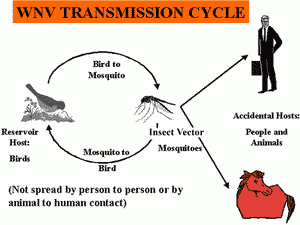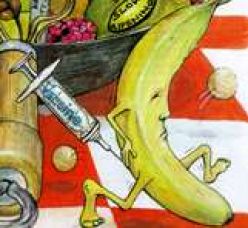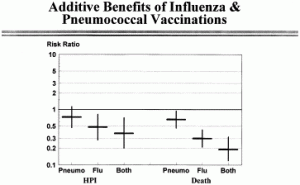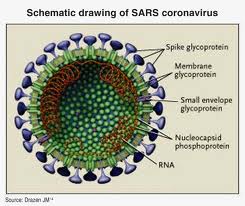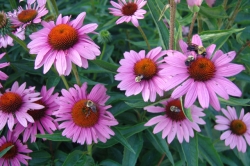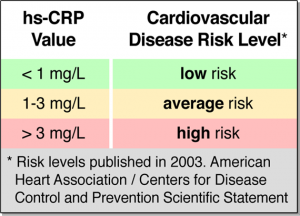West Nile Virus (WNV) is a flavivirus. Related flaviviruses cause Dengue fever and Yellow fever. The reason WNV has been on the news is that until 1990 the virus has not been observed in North America.
Up to that point it was only known to be present in Africa, India, the Middle East, southern France, the former Soviet Union and Indonesia. But since 1999 WNV has been spotted in dead crows in New York and recently also in Toronto/Ont. It is predicted that in 2003 the virus likely will reach the western parts of Canada. It has been spotted already in Washington late in 2002. It is mainly transmitted between birds and mosquitoes. Humans only get infected with WNV through infected mosquito bites. Only about 1% of all mosquitoes are infected with the WNV in endemic areas. The incubation time is 2 to 15 days after a mosquito bite.
Symptoms:
About 80% of people who get infected with West Nile Virus are without symptoms. About 19% will develop mild flu-like symptoms with muscle aches, a fever and a headache.
There may also be a skin rash and swollen lymph glands. After a week or less the symptoms disappear and the patient has recovered. In 1% of patients the infection can be severe with a high fever, a headache and a stiff neck due to meningitis.
Meningitis in this case is from an infection and inflammation of the lining of the spinal cord and brain with the WNV. In some more severe cases the virus can enter the brain tissue and cause a viral encephalitis with a high death rate. People over 50 years of age are particularly susceptible for developing the more severe forms, which often lead to death. Extreme muscle weakness and headaches are usually the presenting symptoms along with a high fever. They may turn unconscious, particularly with encephalitis, may stop breathing and may need to be intubated and put on a ventilator.
Diagnostic tests:
After clinicial suspicion the physician likely will either do a blood test or do a spinal puncture to remove a sample of spinal fluid for specific anti-WNV antibody testing.
Prevention:
The risk is very small as stated above as only 1% of mosquitoes are infected. Prevention consists in steps to prevent mosqitoes from breeding and to prevent them from stinging you. Instal screens on doors and windows.
Stay indoors at dawn, dusk and in the ealry evening. Avoid forested areas during the course of the day. Wear light colored, baggy clothes ( mosquitoes like dark clothes) with long sleeves and long pants. Your lawn should be mowed short to cut down on places for mosquitoes to hide. Still waters such as in clogged gutters, in saucers under plant pots, puddles of water under tarps or in old tires need to be eliminated. Bird feeders need to be flushed out with a garden hose every two to three days to interrupt the mosquito breeding cycle. Use a mosquito repellant with DEET in it (should not contain more than 30% for adults or 10% for children to avoid toxicity). Do not use DEET on children younger than 6 months old.
Treatment:
At the present time there is no treatment other than supportive therapy in hospital for sick patients. Remember that the main breeding cycle in nature for WNV is between birds and mosquitoes. As humans we need to watch that we stay “out of the loop” by following the above preventative measures.
Here are a few useful links regarding West Nile Virus:
Health Canada site on West Nile Virus
CDC site on West Nile Virus (question and answer style)
Last edited December 9, 2012
